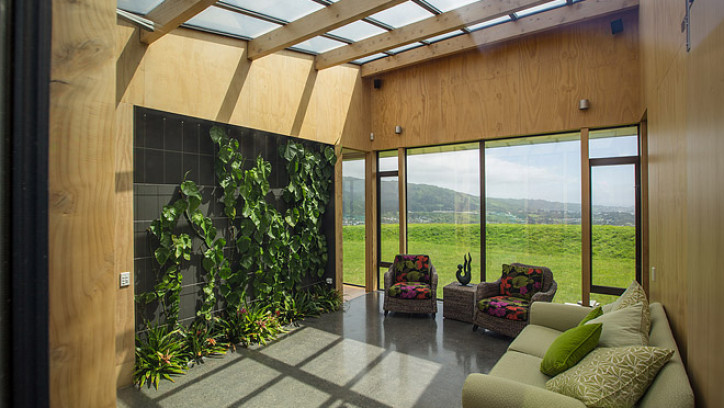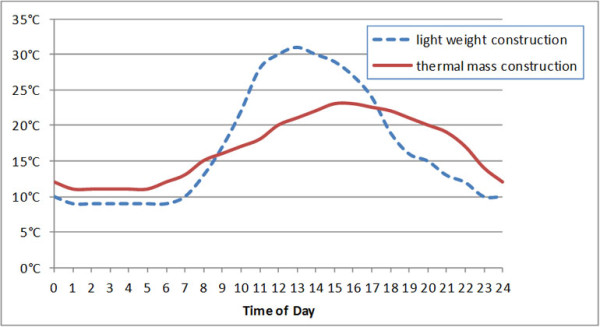Using thermal mass for heating and cooling
Last updated: 9 August 2023

Some building materials are good at absorbing and storing the sun's heat.
Thermal mass keeping your home comfortable
These materials are heavy and dense, and therefore high in what is technically called thermal mass. Common materials used for thermal mass include concrete or filled concrete block, stone or masonry usually used in floors or walls.
Used properly – the right amount in the right place, with proper external insulation – thermal mass can help maintain comfortable temperatures inside your home year-round. Thermal mass will absorb heat from the sun during the day and radiate it out as the temperature drops in the afternoon throughout the evening.
The effect of thermal mass on room temperature at different times of the day

Thermal mass reduces the room temperature during midday and early afternoon and increases the room temperature late in the afternoon and early evening hours.
Building thermal mass into your new home or renovation doesn’t have to increase costs. The money used for a carpet could for example instead be spent on polishing an exposed concrete floor.
Thermal mass materials
Probably the simplest form of thermal mass is a concrete slab floor. You can also use concrete blocks, tiles, brick, rammed earth and stone. Three factors determine how good a material is at absorbing and storing heat.
The ideal material is:
- dense and heavy, so it can absorb and store significant amounts of heat (lighter materials, such as wood, absorb less heat)
- a reasonably good heat conductor (heat has to be able to flow in and out)
- has a dark surface, a textured surface or both (helping it absorb and re-radiate heat).
Different thermal mass materials absorb varying amounts of heat, and take longer (or shorter) to absorb and re-radiate it. For example, a brick wall has higher thermal mass than a timber framed cavity wall, so it will absorb more heat than a timber framed wall of the same thickness.
When the sun is shining into a room and the air is warm, heat will be absorbed by the walls, floor and other surfaces in the room.
How much heat they can hold depends on what they're made of and how thick they are. Some materials can absorb a lot of heat without warming up very much. Others will become quite warm after absorbing small amounts of heat. Thermal mass materials belong to the former. That means that if, for example, a concrete slab floor is exposed to direct sunlight it will be able to absorb and store a lot of heat and release it slowly.
A different material, for example a timber floor, cannot absorb and store as much heat, so what heat it does absorb is released quickly. As a result, much of the energy in the sunlight will quickly end up in the surrounding air, increasing your room temperature during the warmest parts of the day.
You can compare thermal mass to a sponge. Much of the water hitting it will be absorbed. A material with little thermal mass properties will behave more like a plain surface. Any water hitting it will bounce back and end up in the air.
In winter, properly designed thermal mass will absorb the heat from the sunlight on it during the day. Then, as the air temperature drops, the heat will move from the warmer thermal mass to the cooler air and other surfaces in the room.
In summer, thermal mass inside a dwelling should be shaded from direct sunlight for the entire day and be exposed to cooling breezes to provide some cooling on hot days and nights.
For thermal mass to work effectively:
- it needs to be well insulated on the outside (or in the case of a slab floor, underneath and along its vertical edges)
- it needs to receive direct sunlight in winter (coming in through glazing)
- its interior surface must not be covered by insulating materials, such as carpet or vinyl, and ideally be dark colour.
The interaction of insulation, glazing and thermal mass is complex and varies with climate and seasons. Because of this it is important to ask an expert in solar design, such as a designer, architect or building scientist who specialises in passive solar design, to advise you on the best option for your situation.
TIP - Thermal mass
If you cover your thermal mass concrete slab floor with carpets or vinyl, you will reduce much of the sun’s radiation being absorbed into the floor and less of the heat will be released later when it is colder.
To get the most out of your slab floor, leave it exposed or tile it with ceramic or stone tiles.
TIP - Insulation
Remember that your first priority should always be your insulation, including the use of windows with high R-values. If your home is poorly insulated, thermal mass can even make your house less comfortable and increase your energy use.
Where you should put thermal mass
Thermal mass should be placed where it will best be able to absorb heat in the colder months and be shaded in the warmer months. This means it is best to put it near windows or other glazed areas where it will be exposed to direct sunlight in winter. The north side of the house is generally best.
You can also put thermal mass near a woodburner, heater or another source of radiant heat.
TIP - Thermal mass floor or wall
A thermal mass floor or wall exposed to direct sunlight is more effective than one only exposed to diffused sunlight, and hundreds of times more effective as one only exposed to warm air. Rather than a fully exposed concrete slab, you could consider just exposing a strip along the sunny side of a room.
Where you shouldn't put thermal mass
Thermal mass can be a liability if used incorrectly, so it should be kept away from:
- cold, draughty areas such as entryways or unheated hallways
- rooms that face south or don't get much winter sun
- areas with poor insulation.
Well-insulated, lightweight construction walls are suitable for cool, draughty areas and south-facing rooms.
Thermal mass in floors
In most climate conditions a concrete slab, insulated underneath and around the edges, is the most effective way to increase thermal mass. This can form the whole floor, but just as effective is a strip of polished or tiled concrete along the sunny side of the room or a slab floor which is exposed around the edges with mats or carpet in the centre. Concrete slab floors should be insulated both underneath and around the edges.
Other floor options include brick, compressed earth or a suspended concrete slab in rooms with north-facing windows, with external insulation.
The surface can be polished or tiled where exposed to the sun. Surfaces exposed to direct sunlight shouldn't be covered with rugs or carpet, as this reduces the amount of heat the thermal mass can absorb.
Thermal mass in walls
Brick, concrete, concrete block (including insulated and aerated types) and rammed earth can be used for internal or external walls if they catch the sun or are close to a radiant heat source. Walls can either be solid or an internal veneer.
External thermal mass walls must be insulated on the external surface to prevent heat loss, and exposed on the inside of the house (that is, without internal lining, but it can be plastered, stained, tiled, painted or wall-papered). Various methods and proprietary systems are now available to design and retrofit insulated concrete block, precast concrete panel, or poured concrete walls. These include:
- Insulating panels that can be fitted to the outside of new and existing concrete and concrete block walls.
- Precast concrete 'sandwich' panels, which have a layer of insulation between two layers of concrete.
Polystyrene formwork (or shuttering) systems are available for concrete walls. In some cases the polystyrene on the internal surface can be removed, however its insulation benefits usually outweigh the thermal mass benefits.
How much thermal mass do you need?
Area
The area of exposed thermal mass should be balanced against the area of glazing. You don't want to have so much glass that the room overheats in summer and loses heat too fast in winter.
As a rule of thumb, the exposed area of thermal mass should be about six times the area of glass that receives direct sunlight. For example, a north-facing room with a 1m2 window should have about 6m2 of exposed thermal mass, located where it will be exposed to direct winter sun. The exact glass-to-mass area ratio will of course vary with climate and design.
Your passive solar design expert can optimise the amount and placement of both glazing and thermal mass by using hour-by-hour simulations of the design.
Thickness
Concrete slab floors should be 100 – 200mm thick for the best performance, while thermal mass walls should be 100 – 150mm thick. Very thick thermal mass walls and floors may take too long to heat, while those that are too thin won't store enough heat. The exact amount should be calculated as part of the design process.
To prevent the potential for overheating thermal mass in summer, it's important to design appropriate eave widths.
Other things to consider
Insulation
Good insulation (including glazing) is essential to maximise the benefits of thermal mass. It's vital that thermal mass is insulated from outside temperature fluctuations. Without insulation, thermal mass can be a liability – radiating cold and exacerbating damp conditions in winter.
Thermal mass that doesn't receive sunlight
Consider insulating the inside of high thermal mass walls which don’t receive direct sunlight or store heat from nearby radiant heat sources. This is particularly important if you only heat for part of the day – the thermal mass will absorb heat from the air until it is the same temperature.
Concrete drying
If you are using concrete as thermal mass in a floor or wall, you need to be aware that it will not perform at its best until it has dried out. Drying time will vary depending on humidity and thickness. A 100mm thick slab can take four months to dry out (longer in winter), and thicker slabs will take longer. During that time it is particularly important to ventilate the house regularly to avoid the build-up of internal moisture.